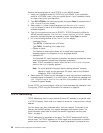
server) was removed from the menu. Option 12, formerly Change local
domain and host names, was renamed to Change TCP/IP domain
information.
v Option 20. Configure TCP/IP applications: Select this option to configure the
TCP/IP applications that are installed on your system. The list of applications
varies depending on whether the TCP/IP licensed program is installed on your
system. If the TCP/IP licensed program is not installed on your system, you can
configure
only
the following server applications:
– Simple Network Management Protocol (SNMP)
– Bootstrap Protocol (BOOTP) server
– Trivial File Transfer Protocol (TFTP) server
– Route Daemon (RouteD)
If the TCP/IP licensed program is installed on your system, you can configure the
following server applications:
– Simple Mail Transfer Protocol (SMTP)
– File Transfer Protocol (FTP), TELNET
– Post Office Protocol (POP) Version 3 mail server
– Line Printer Daemon (LPD)
– Remote Execution (REXEC) server
– Workstation gateway applications
– Simple Network Management Protocol (SNMP)
For information about configuring SNMP, see the
Simple Network Management
Protocol (SNMP) Support
book.
v Option 21. Configure related tables: Select this option to configure the tables
related to TCP/IP. These tables are:
– Protocol table
Contains a list of protocols used in the Internet.
– Services table
Contains a list of services and the specific port and protocol a service uses.
– Network table
Contains a list of networks and the corresponding IP addresses for that
network.
v Option 22. Configure point-to-point TCP/IP: Select this option to define,
change, or display your TCP/IP point-to-point (SLIP) configuration.
Configuring TCP/IP using the Command Line Interface
The following steps using the command line interface will guide you through
configuring TCP/IP on your AS/400 system:
1. Configuring line descriptions
2. Configuring TCP/IP interfaces
3. Configuring TCP/IP routes
4. Configuring TCP/IP attributes
5. Configuring remote system information (X.25)
6. Configuring host table entries
Chapter 2. Configuring TCP/IP 29


















